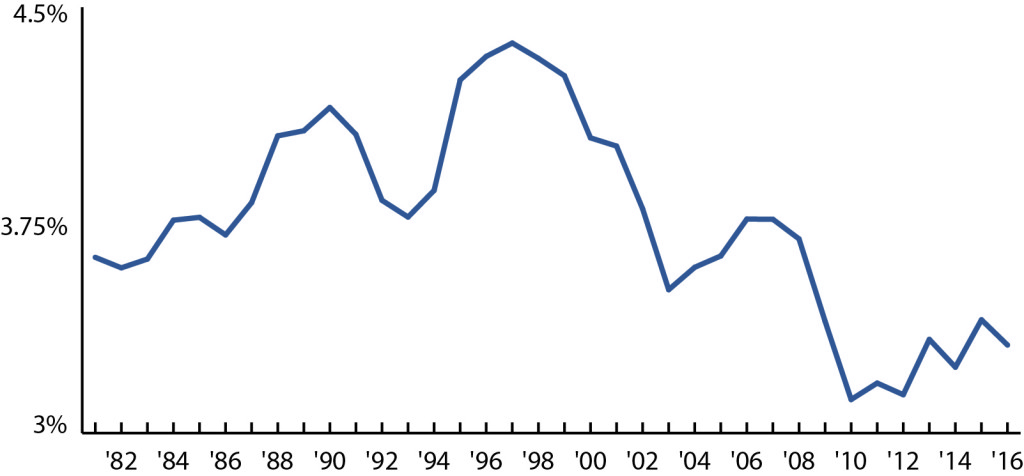A stunning state revenue collapse in the final days of the last fiscal year (FY2016, which ended on June 30th) may continue to hamper Missouri’s ability to meet the educational, health, and other needs of Missourians.
Decreased revenue in the month of June prompted the Governor to restrict state spending for critical services including for early education, schools, programs for Missourians with disabilities and more.[1]
In addition, the poor growth postponed income tax cuts that were scheduled to begin phasing in during 2017. However, those cuts still loom over the horizon for 2018 and would cost the state revenue that could be used for schools, transportation, and other investments in a strong economy.
Moreover, additional budget shortfalls may again jeopardize services for Missourians this year, and create strains for next year. Pending tax cuts would aggravate the situation further.
- Because of the FY 2016 general revenue shortfall, revenue needs to grow about 6.5 percent in the new budget year in order to fully fund the FY 2017 state budget approved by lawmakers. The amount of needed growth is far above the budgeted projection of 4.1 percent.
- If state revenue grows at the lower, projected rate of 4.1 percent, Missouri will face a $216 million budget shortfall for the current fiscal year.
- Should the legislature choose to override the Governor’s vetoes of further tax reductions passed in the 2016 legislative session, the budget will be further strained.
Relative to the Economy, FY 2016 GR Collections Among Lowest in 35 Years
GR as % of Personal Income, Fiscal Years 1981-2016
 Moreover, due to the drop in state revenue, Missouri ended the last budget year with general revenue tax collections among the lowest in 35 years, as a percent of personal income in the state – one measure of the economy.
Moreover, due to the drop in state revenue, Missouri ended the last budget year with general revenue tax collections among the lowest in 35 years, as a percent of personal income in the state – one measure of the economy.
Late FY 2016 Revenue Collapse
Until late June of this year, Missouri’s revenue had been on track to meet the original projection of 2.8 percent growth for FY 2016. However, general revenue collections plummeted during the final ten days of June, resulting in just 0.9 percent growth compared to the previous year, well below the budgeted amount.[2]
During the last ten days of June, revenue collections were 50 percent lower than the same period in the previous year. Further, revenue for the entire month of June declined by 23 percent compared to the previous year. While revenue collections can fluctuate considerably over brief time periods, the drop was largely unexpected, and left the state about $169 million short of the amount that was projected and on which the budget was based. Governor Nixon responded to the decline in revenue by announcing $115.5 million in budget restrictions/withholding for FY 2017 on July 6th.
Further, the late June revenue collapse also left the state with a much smaller beginning balance of about $153 million at the start of the new budget year on July 1. Relative to the size of the budget, this is an extremely low amount.
The New Budget Outlook: Shortfalls Lurking
As a result of the FY 2016 general revenue shortfall, state revenue needs to grow about 6.5 percent in the new budget year, FY 2017, in order to fully fund the state budget that was approved by lawmakers. The amount of needed growth is far above the budgeted projection of 4.1 percent.
Assuming that revenue grows at the lower, original estimate, Missouri could face a $216 million shortfall for the new fiscal year. This shortfall would be worsened should the General Assembly choose to override any of the Governor’s vetoes of several tax cut bills that were passed during the 2016 legislative session.
Moreover, as income tax cuts that were approved in 2014 take effect, Missouri’s ability to fund education and other services Missourians rely on will be further impaired in fiscal year 2018.
Missouri Will Likely Face Significant Revenue Shortfalls in FY 2017 & FY 2018
General Revenue Summary FY 2013 – FY 2018, Amounts in Millions
|
FY 13 |
FY 14 |
FY 15 |
FY 16 |
FY 17 |
FY 18 |
| Resources |
|
|
|
|
|
|
|
|
|
|
|
|
|
| Beginning Balance |
$64.1 |
$329.7 |
$18.3 |
$12.6 |
$0.0 |
($215.8) |
| Previous Year Lapse |
$139.7 |
$117.2 |
$170.5 |
$265.0 |
$153.2 |
$150.0 |
| Net GR Collections |
$8,082.6 |
$8,003.3 |
$8,709.2 |
$8,786.8 |
$9,151.0 |
$9,517.0 |
| Tax Reductions |
$0.0 |
$0.0 |
$0.0 |
$0.0 |
($7.7) |
($71.5) |
| Signed Tax Cuts from 2016 Session |
$0.0 |
$0.0 |
$0.0 |
$0.0 |
($7.7) |
($21.5) |
| SB 509 |
$0.0 |
$0.0 |
$0.0 |
$0.0 |
$0.0 |
($50.0) |
| Collection Additions |
$0.0 |
$0.0 |
$0.0 |
$0.0 |
$29.9 |
$30.0 |
| Transfers to GR |
$184.8 |
$123.9 |
$123.7 |
$114.8 |
$77.0 |
$80.0 |
|
|
|
|
|
|
|
| Total Resources Available |
$8,471.2 |
$8,574.1 |
$9,021.7 |
$9,179.2 |
$9,403.4 |
$9,489.7 |
|
|
|
|
|
|
|
|
|
|
|
|
|
|
| Obligations |
|
|
|
|
|
|
|
|
|
|
|
|
|
| Operating Appropriations |
$8,013.8 |
$8,276.7 |
$8,734.9 |
$8,854.8 |
$9,526.4 |
$9,410.9 |
| Vetoes (includes CI) |
$0.0 |
$0.0 |
$0.0 |
$0.0 |
$0.0 |
$0.0 |
| Expenditure Restrictions (includes CI) |
$0.0 |
($53.0) |
($66.9) |
($46.1) |
($115.5) |
$0.0 |
| Higher Education |
$0.0 |
$0.0 |
$0.0 |
$0.0 |
$0.0 |
$0.0 |
| State Worker Pay Plan |
$0.0 |
$0.0 |
$0.0 |
$0.0 |
$0.0 |
$0.0 |
| Medicaid |
$0.0 |
$0.0 |
$0.0 |
$0.0 |
$0.0 |
$0.0 |
| All Other “Normal” Growth |
$0.0 |
$0.0 |
$0.0 |
$0.0 |
$0.0 |
$0.0 |
| Re-Appropriations |
$0.0 |
$0.0 |
$0.0 |
$40.4 |
$37.5 |
$50.0 |
| Lapse |
$0.0 |
$0.0 |
$0.0 |
($87.7) |
$0.0 |
$0.0 |
| Supplemental/Estimated Appropriations |
$57.7 |
$220.9 |
$135.4 |
$324.0 |
$50.3 |
$125.0 |
| Capital Appropriations |
$70.0 |
$111.2 |
$205.7 |
$93.8 |
$120.5 |
$100.0 |
|
|
|
|
|
|
|
| Total Obligations |
$8,141.5 |
$8,555.8 |
$9,009.1 |
$9,179.2 |
$9,619.2 |
$9,685.9 |
|
|
|
|
|
|
|
|
|
|
|
|
|
|
| Ending Balance |
$329.7 |
$18.3 |
$12.6 |
$0.0 |
($215.8) |
($196.2) |
[1] Office of Administration, Division of Budget & Planning http://oa.mo.gov/commissioners-office/news/state-releases-june-2016-general-revenue-report
[2] Expenditure restrictions made by the Governor can be seen here: http://oa.mo.gov/sites/default/files/FY_2017_Expenditure_Restrictions_07_06_16.pdf









